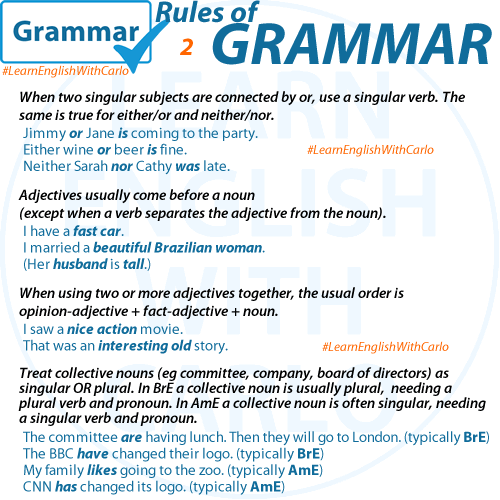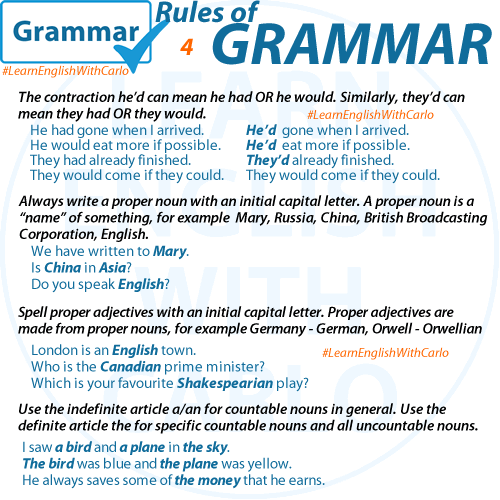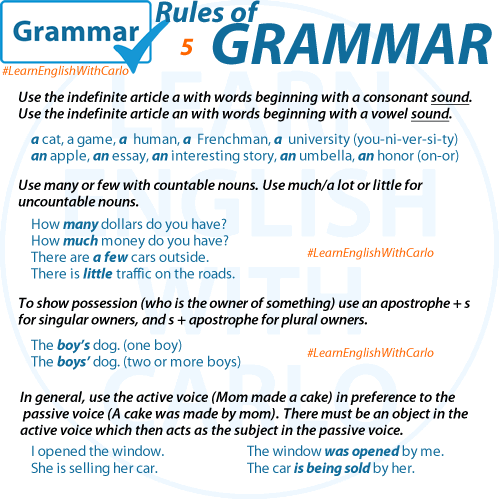Mastering English grammar helps you communicate clearly and naturally. Here’s a guide to some fundamental rules, complete with examples and exceptions to be aware of.
1. Indefinite Articles (A/An)
- Use a with words that begin with a consonant sound:
- a cat, a game of golf, a university (you-ni-ver-si-ty)
- Use an with words that begin with a vowel sound:
- an apple, an easy job, an honorable man (on-o-ra-ble)
- Exceptions:
- Words beginning with silent letters can be tricky. An hour (silent “h”) but a hotel (if “h” is pronounced).
2. Countable and Uncountable Nouns with Quantifiers
- Use many or few with countable nouns:
- How many books do you have?
- There are few seats available.
- Use much, a lot of, or little with uncountable nouns:
- How much information do you need?
- There’s a lot of sugar in this recipe.
- Exception:
- Some nouns can be both countable and uncountable, depending on meaning (e.g., I love coffee vs. I had two coffees this morning).
3. Possessive Form with Apostrophes
- Singular possessive: add ‘s
- The child’s toy (one child)
- My friend’s house
- Plural possessive: add s’
- The teachers’ lounge (several teachers)
- My parents’ decision
- Exception:
- For plural nouns that don’t end in “s,” add ‘s: The children’s playground, the men’s department.
4. Active vs. Passive Voice
- Active voice is generally clearer and preferred:
- Cats eat fish (active) vs. Fish are eaten by cats (passive).
- Passive is sometimes preferred for focus on the action or when the subject is unknown:
- The results were published yesterday.
5. Contractions: ‘He’d’, ‘They’d’, and More
- He’d can mean he had or he would:
- He had eaten when I arrived.
- He’d finish if he had time.
- They’d can mean they had or they would:
- They had completed the task.
- They’d like to join if possible.
6. Proper Nouns and Adjectives
- Proper nouns (names) start with a capital letter:
- Anna, Tokyo, Brazil
- Proper adjectives, derived from proper nouns, are also capitalized:
- Japanese cuisine, Shakespearian play, Mexican culture
- Exceptions:
- Some brand names or organizations may stylize their names without capitalization (e.g., iPhone, eBay).
7. Definite and Indefinite Articles (The, A/An)
- Use a/an for general items:
- I saw a cat in the garden.
- Use the for specific items mentioned earlier or known by the listener:
- The cat was playing with a ball.
- Use the for uncountable nouns when specific:
- The water is too cold.
8. Common Confusing Words: It’s vs. Its, Your vs. You’re
- It’s = it is or it has
- It’s raining.
- It’s been a long day.
- Its = possessive:
- The company has changed its policy.
- You’re = you are
- You’re my best friend.
- Your = possessive:
- Is this your book?
9. Subject-Verb Agreement with Compound Subjects
- When subjects are connected by or, use a singular verb:
- Either the teacher or the student is responsible.
- For either/or and neither/nor:
- Neither Tom nor Sarah was available.
10. Order of Adjectives
- Adjectives usually precede a noun. When using multiple adjectives, the order is usually opinion + size + age + color + origin + material + type + purpose:
- a beautiful small Italian marble table
- a delicious hot vegetable soup
- Exceptions:
- Familiar expressions may not follow these rules, e.g., big bad wolf.
11. Collective Nouns: Singular or Plural?
- In British English, collective nouns are typically treated as plural:
- The team are preparing their uniforms.
- In American English, collective nouns are treated as singular:
- The team is preparing its uniform.
12. Basic Sentence Structure and Capitalization
- Sentences start with a capital letter and end with a period, question mark, or exclamation mark:
- What time is it?
- We’ll see you soon!
13. Subject-Verb-Object Order
- The standard order in English is Subject-Verb-Object:
- The dog chased the ball.
- In questions, the order often changes to Verb-Subject:
- Is she coming?
14. Every Sentence Needs a Subject and a Verb
- Each sentence needs a subject and verb, and they must agree in number:
- Anna reads every day.
- The children play outside.
- Exception:
- Imperative sentences (commands) may only have a verb, with the subject understood: Sit down. (You sit down.)





